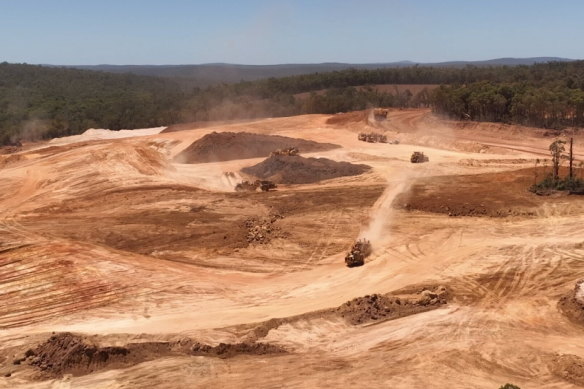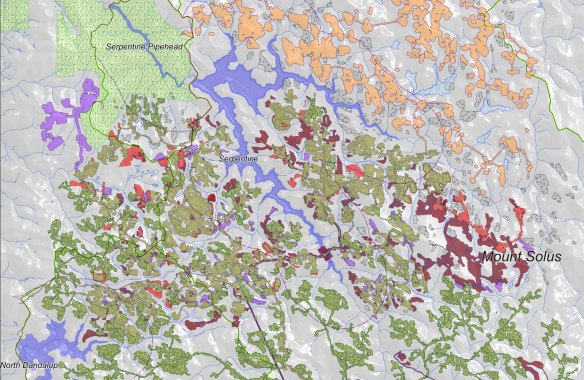- Exclusive
- National
- WA
- Alcoa investigation
This was published 11 months ago
Worries of ‘irreversible’ damage to jarrah forest by Alcoa revealed
By Peter Milne
Alcoa’s strip mining will permanently and irreversibly damage the jarrah forest in south-west WA and contamination of the water supply is “considered certain”, according to an internal Water Corporation assessment obtained by this masthead.
The utility’s analysis of the mining Alcoa plans to carry out to 2027 was uncovered after a seven-month wait for a response to a freedom of information request. It concluded bauxite mining in the catchments for its dams was “the single most significant risk to water quality in Perth and the South West”.
The biggest concern is Serpentine Dam, responsible for almost one-fifth of the system’s water supply by catching rainfall runoff and storing desalinated water.

The 280 square kilometres of jarrah forest cleared by Alcoa to date makes its WA operation one of the biggest mines in the world.Credit: Nine News Perth
Clearing of the jarrah forest makes it more likely that large sediment flows into the dams after heavy rainfall could render water treatment plants inoperable.
Upgraded facilities for all dams near mining would cost about $2.6 billion and double the cost of water.
Contamination from oil and the toxic forever chemical PFAS spilled by Alcoa are also a concern.
Longer term, state-owned Water Corporation is worried about the removal of much of the bauxite layer between topsoil and bedrock that absorbs water and allows it to move to different areas of the forest.
“Mining impacts are persistent and irreversible, with little evidence that mined areas can be effectively returned to an equivalent pre-mining state,” the report stated.
In 2023, this masthead revealed Alcoa had not met the government’s rehabilitation completion criteria for any of the 280 square kilometres of forest it had cleared over six decades.
However, Alcoa disputed this conclusion.
“Research has found that bauxite mining does not fundamentally change jarrah forest catchment hydrology and resilience,” a spokesman for the miner said, adding that it was the deeper permanent groundwater that was more important.
The area of water catchment affected may be much more than the 188 square kilometres cleared or approved for clearing.
Water Corporation estimated the “relatively commonplace” tree deaths on the edges of the mined areas more than doubled the impacted area to 380 square kilometres.
The report warns that the full impact of mining may not take effect for decades and will be magnified by climate change, with its resultant dryer, hotter weather and more frequent and severe bushfires.
For this reason, management of the forest cannot just rely on detection of negative impacts, as by that stage it would be too late to take action.
The water utility concerns mirror those of WA’s environmental regulator, as revealed by this masthead, which rejected Alcoa’s plan “in its entirety”.
The Alcoa spokesman said the company was confident its practices would continue to protect the water supply.
“We are focussed on operating responsibly and in line with recent requirements which include enhanced protections for drinking water, limited forest clearing and accelerated rehabilitation,” he said.
In December 2023, the state government imposed additional conditions on Alcoa.
The Water Corporation report recommended Alcoa not clear slopes steeper than 16 per cent where sediment runoff is more likely, but the government only applied this restriction to the “reservoir protection zone” (RPZ) within two kilometres of dams.

Alcoa’s mining near Serpentine Dam: green - approved, reds - approved in December 2023, apricot - yet to be approved expansionCredit: Water Corporation
The utility also wanted no more than 30 per cent of each valley feeding into a dam to be cleared, but again the government only applied this to the RPZ. It had recommended no mining at all within the RPZ.
When asked if present arrangements reduced the risks to the water supply to a level it was comfortable with, a Water Corporation spokesman said its highest priority was the protection of drinking water supplies and that it was working with other government departments to achieve that.
Premier Roger Cook said in May that his government had brought Alcoa into a modern environmental protection regime while still protecting jobs.
“With any resource project we have to balance out the rights of the mining company against the environmental impacts of their programs,” he said.
Start the day with a summary of the day’s most important and interesting stories, analysis and insights. Sign up for our Morning Edition newsletter.